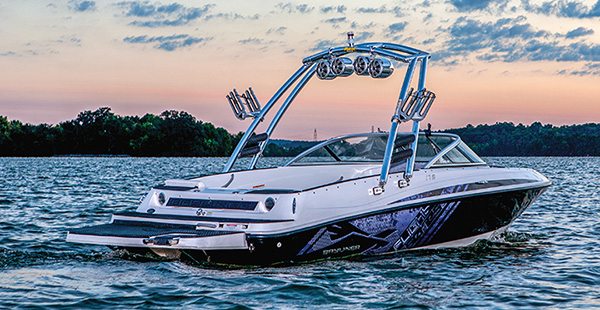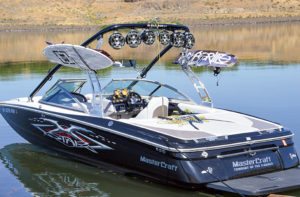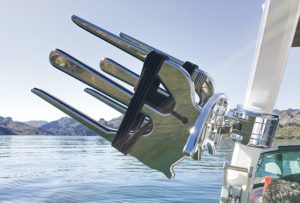As the tow boat category surges, so too has the market for aftermarket wake towers and accessories

With year after year of double-digit growth, the strength of the tow boat category is beyond dispute. But with the price of tow boats now averaging close to $100,000, many boaters prefer to pimp their existing ride rather than replace it altogether. That’s especially true for families on tight budgets, or those who aren’t convinced that their kids’ interest in water sports will last. For these boaters, aftermarket towers and tower accessories represent an affordable way of getting into water sports without committing to a six-figure purchase.
“There are a huge number of boaters who are perfectly happy with their existing boat, they just wish it had a tow point,” said Steven Beck, general manager at Monster Towers. “An aftermarket tower gives them that capability. It’s a cost-effective way to enjoy water sports and breathe new life into the family runabout.”
By raising the tow point to an elevated position, towers make it easier for boarders to get up, and they give wakeboarders more hang time on jumps. It’s a noticeable improvement over the traditional transom-mounted ski pylon, which tends to pull boarders down toward the water. The first commercial wakeboard towers emerged in the mid-1990s, taking a cue from the tuna towers often used on offshore fishing boats.
“A Mastercraft 205 was a popular boat in the 90s,” said Samson Towers President Scott Parnell. “And although none of them came with towers, today pretty well all of them have a tower on them. If you see one without a tower you think wow, that’s unusual.”
 Apart from making it easier to enjoy wakeboarding or wakesurfing, towers also provide a convenient place to store wet wakeboards, keeping them out of the boat and off the seats. They also provide an ideal location to mount mirrors, speakers, lights and cameras, and let’s face it – they just look cool.
Apart from making it easier to enjoy wakeboarding or wakesurfing, towers also provide a convenient place to store wet wakeboards, keeping them out of the boat and off the seats. They also provide an ideal location to mount mirrors, speakers, lights and cameras, and let’s face it – they just look cool.
“To be perfectly honest, we have a number of customers who bought towers with no intention of going wakeboarding at all – they just wanted the look of that boat,” said Beck. “They wanted the look, and they wanted the ability to mount speakers and a Bimini top. Positioning the stereo speakers on an overhead arch gives such a boost to any sound system, and that’s a major attraction for a lot of customers.”
Today’s tower market has become increasingly polarized, between universal-fit towers that compete primarily in the aftermarket, and custom-fit towers that are increasingly sold to boat builders as an OEM component.
“Fifteen years ago, maybe 10 percent of our business was OEM, and 90 percent was aftermarket,” said Parnell. “Now, maybe 75 percent is OEM and 25 percent is aftermarket. Today you can order virtually any boat with a tower on it.”
“Most of the market is driven by OEM, you’ll be hard-pressed to find anyone buying a tow boat today without a tower on it,” said Tyson Kochan, chief operating officer at Roswell Marine. “But there are a lot of older boats out there that just don’t have one. So while the market may be driven by OEM, aftermarket is still critically important. The light, strong universal towers add a lot of value to older boats.”
Forward looking statements
 Where aftermarket towers have traditionally used four-point mounting systems with legs on either side of the windshield, contemporary forward-arching towers now command the greatest attention from tower buyers. They’re typically stronger, and with no framework extending forward of the windshield, there’s no chance of potentially obstructing the driver’s field of vision.
Where aftermarket towers have traditionally used four-point mounting systems with legs on either side of the windshield, contemporary forward-arching towers now command the greatest attention from tower buyers. They’re typically stronger, and with no framework extending forward of the windshield, there’s no chance of potentially obstructing the driver’s field of vision.
“They definitely make a statement,” said Beck. “Beyond that, the forward-arching towers also tend to be a lot easier to collapse. That’s an important consideration for customers who store their boat in a garage, people who tow their boat or anyone who needs to pass beneath low bridges.”
A growing number of towers have begun to adopt gas-assist systems to facilitate raising and lowering them.
“Even if you put 100 pounds of speakers on it, gas assist lets you still raise or lower the tower with just two fingers,” said Parnell. “It makes a huge difference, allowing anyone to raise or lower the tower. Power lift mechanisms are also growing more popular. They’re convenient at the end of the day, and it looks impressive to just push a button and have the tower drop down while your friends are standing there watching. They definitely draw a lot of attention at boat shows.”
While anodized or chrome finishes have long dominated the tower market, in recent years powder-coated finishes have begun to overtake them in unit sales, said Parnell.
“A lot of that is simply matching the more contemporary finishes on newer boats,” he said. “In addition, powder-coated finishes don’t show finger marks or water spots the way that chrome does, so they’re a bit less maintenance as well.”
Accessories count
Increasingly, towers are sold with a wide range of supplied accessories built to cosmetically match the tower itself – from rearview mirrors to stereo speakers to overhead lights to camera mounts and integrated Bimini tops.
 “We’re trying to get the accessories a little more integrated with the towers and more user-friendly,” said Kochan. “We’re seeing that with tower speakers, for example, with speakers moving inside the towers or being tucked up into the corners so no one’s knocking their head on them.”
“We’re trying to get the accessories a little more integrated with the towers and more user-friendly,” said Kochan. “We’re seeing that with tower speakers, for example, with speakers moving inside the towers or being tucked up into the corners so no one’s knocking their head on them.”
Another factor driving the sales of tower accessories are constant developments in wakeboards themselves. Board racks, in particular, have grown far more diverse and complex.
“The sport has progressed to the point that we’re seeing a wider range of boards out there, from one-quarter inch to three inches thick,” said Kochan. “A lot of them just don’t fit in a one-size-fits-all generic rack, so we’ve seen board racks evolve to accommodate them.”
Racks have also become far more user-friendly, replacing the traditional bungee cords with adjustable grips, and providing swivel or tilt bases to keep boaters from having to reach far over the side to secure or retrieve boards.
“There have been a lot of technological changes to make racks strapless, and that’s progressed quite a bit,” said Kochan. “There are now clapping-type racks, and we have our Triton rack that uses a securing system that moves with the boat so you have no chatter as the boat moves along. We’re also redesigning racks so they drip water outside of the boat, instead of all over the seats.”
While all of these upgrades increase costs, the price of even high-end aftermarket towers and accessories still represents a cost-effective way for boaters to get in on the fun with their existing runabout. Little wonder the tower and rack segment is posting growth to rival that of tow boats themselves.




